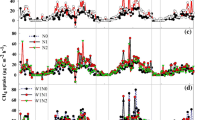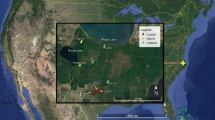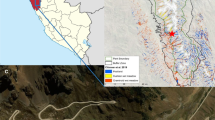Abstract
To quantify the effects of water table drawdown and soil warming on CH4 fluxes, we used a static chamber technique during the growing seasons (May–October) of 2011–2013 at hollow and hummock microforms at three sites of a continental bog near the town of Wandering River, Alberta, Canada: (1) Control, (2) Experimental drained, and (3) old Drained. To simulate climatic warming, we used open top chambers to passively warm half of the hollows and half of the hummocks at each of the water level treatment sites. Water table drawdown significantly reduced CH4 flux by 50% in 3 years and 76% in 13 years of drainage. The hollows showed greater reduction of efflux as compared to hummocks. A persistent functional relationship of CH4 flux with water level was found across all sites in all years. The relationship revealed that the contribution of change in vegetation type at hollows and hummocks to CH4 production and emission was relatively less important than that of the water level. Hummocks and hollows responded to warming differently. At the control, experimental and drained sites, warming increased flux at hollows by 16, 21 and 26%, and reduced flux at hummocks by 4, 37, and 56%, respectively. The combined effect of lowered water table and warming on CH4 emission was overall negative, although the interaction between the two contributing factors was not significant. Therefore, whereas climatic warming and subsequent lowering of water table are expected to reduce CH4 efflux from dry ombrotrophic bogs of Alberta, different microforms at these bogs may respond differently with accelerated emissions at warmed, wetter (hollows) and reduced emissions at warmed, drier (hummocks) microforms. Overall, CH4 efflux from Alberta’s dry continental bogs that are not underlain by permafrost might be affected only slightly by the direct effect of predicted climate warming, although initial water table position will be an important control on the overall response.




Similar content being viewed by others
References
Aerts R, Ludwig F. 1998. Water-table changes and nutritional status affect trace gas emissions from laboratory columns of peatland soils. Soil Biol Biochem 29:1691–8.
Alm J, Shurpali NJ, Minkkinen K, Aro L, Hytonen J, Laurila T, Lohila A, Maljanen M, Martikainen PJ, Makiranta P, Penttila T, Saarnio S, Silvan N, Tuittila E-S, Laine J. 2007. Emission factors and their uncertainty for the exchange of carbon dioxide, methane and nitrous oxide in Finnish managed peatlands. Boreal Environ Res 12:191–209.
Baird AJ, Belyea LR, Morris PJ. 2009. Carbon cycling in northern peatlands: upscaling of peatland-atmosphere fluxes of methane: small scale heterogeneity in process rates and the pitfalls of “Bucket-and-slab” models. Am Geophys Union Geophys Monogr Ser 184.
Blodau C, Moore TR. 2003. Micro-scale carbon dioxide and methane dynamics in a peat soil during a water fluctuation and sulfate pulse. Soil Biol Biochem 35:535–47.
Bokhorst S, Huiskes A, Convey P, Sinclair BJ, Lebouvier M, Van de Vijver B, Wall DH. 2011. Microclimate impacts of passive warming methods in Antarctica: implications for climate change studies. Polar Biol 34:1421–35.
Bridgham SD, Megonigal JP, Keller JK, Bliss NB, Trettin C. 2006. The carbon balance of North American wetlands. Wetlands 26:889–916.
Bubier J, Costello A, Moore T, Roulet N, Savage K. 1993. Microtopography and methane flux in boreal peatlands, northern Ontario, Canada. Can J Bot 71:1056–63.
Carlson M, Chen J, Elgie S, Henschel C, Montenegro A, Roulet NT, Scott N, Tarnocai C, Wells J. 2010. Maintaining the role of Canada’s forests and peatlands in climate regulation. For Chron 86:434–43.
Carlyle CN, Fraser LH, Turkington R. 2011. Tracking soil temperature and moisture in a multi-factor climate experiment in temperate grassland: do climate manipulation methods produce their intended effects? Ecosystems 14:489–502.
Chivers M, Turetsky M, Waddington J, Harden J, McGuire A. 2009. Effects of experimental water table and temperature manipulations on ecosystem carbon dioxide fluxes in an Alaskan rich fen. Ecosystems 12:1329–42.
Couwenberg J, Fritz C. 2012. Towards developing IPCC methane ‘emission factors’ for peatlands (organic soils). Mires Peat 10:1–17.
Crill PM, Bartlett KB, Harriss RC, Gorham E, Verry ES. 1998. Methane flux from Minnesota peatlands. Glob Biogeochem Cycles 2:371–84.
Davidson EA, Janssens IA. 2006. Temperature sensitivity of soil carbon decomposition and feedbacks to climate change. Nature 440:165–73.
Dinsmore KJ, Skiba UM, Billett MF, Rees RM. 2009. Effect of water table on greenhouse gas emissions from peatland mesocosms. Plant Soil 318:229–42.
Elmendorf SC, Henry GH, Hollister RD, Björk RG, Bjorkman AD, Callaghan TV, Collier LS, Cooper EJ, Cornelissen JH, Day TA. 2012. Global assessment of experimental climate warming on tundra vegetation: heterogeneity over space and time. Ecol Lett 15:164–75.
Frey KE. 2005. Amplified carbon release from vast West Siberian peatlands by 2100. Geophys Res Lett 32:L09401.
Frolking S, Talbot J, Jones MC, Treat CC, Kauffman JB, Tuittila E-S, Roulet N. 2011. Peatlands in the Earth’s 21st century climate system. Environ Rev 19:371–96.
Funk DW, Pullman ER, Peterson KM, Crill PM, Billings W. 1994. Influence of water table on carbon dioxide, carbon monoxide, and methane fluxes from taiga bog microcosms. Glob Biogeochem Cycles 8:271–8.
Gillett PG, Arora VK, Zickfeld K, Marshall SJ, Merryfield WJ. 2011. Ongoing climate change following a complete cessation of carbon dioxide emissions. Nat Geosci 4:83–7.
Gorham E. 1991. Northern peatlands: role in the carbon cycle and probable responses to climatic warming. Ecol Appl 1:182–95.
Hollister RD, Webber PJ. 2000. Biotic validation of small open-top chambers in a tundra ecosystem. Glob Change Biol 6:835–42.
Hollister RD, Webber PJ, Nelson FE, Tweedie CE. 2006. Soil thaw and temperature response to air warming varies by plant community: results from an open-top chamber experiment in northern Alaska. Arct Antarct Alp Res 38:206–15.
Howarth RW, Santoro R, Ingraffea A. 2011. Methane and the greenhouse-gas footprint of natural gas from shale formations. Clim Change 106:679–90.
IPCC. 2007. Impacts, adaptation and vulnerability: contribution of working group II to the fourth assessment report of the intergovernmental panel on climate change. ML Parry, OF Canziani, JP Palutikof, PJ van der Linden, CE Hanson, Eds. Cambridge: Cambridge University Press. p 976
Ise T, Dunn AL, Wofsy SC, Moorcroft PR. 2008. High sensitivity of peat decomposition to climate change through water-table feedback. Natre Geosci 1:763–6.
Jennrich RI, Schluchter MD. 1986. Unbalanced repeated-measures models with structured covariance matrices. Biometrics. 42:805–20.
Johnson C, Pypker T, Hribljan J, Chimner R. 2013. Open top chambers and infrared lamps: a comparison of heating efficacy and CO2/CH4 dynamics in a Northern Michigan Peatland. Ecosystems 16:736–48.
Keller JK, Bridgham SD. 2007. Pathways of anaerobic carbon cycling across an ombrotrophic–minerotrophic peatland gradient. Limnol Oceanogr 52:96–107.
Kettles IM, Tarnocai C. 1999. Development of a model for estimating the sensitivity of Canadian peatlands to climate warning. Géog phys Quatern 53:323–38.
Kettunen A, Kaitala V, Alm J, Silvola J, Nykanen H, Martikainen PJ. 2000. Predicting variations in methane emissions from boreal peatlands through regression models. Boreal Environ Res 5:115–32.
Lai D. 2009. Methane dynamics in northern peatlands: a review. Pedosphere 19:409–21.
Laine A, Wilson D, Kiely G, Byrne KA. 2007. Methane flux dynamics in an Irish lowland blanket bog. Plant Soil 299:181–93.
Levy PE, Burden A, Cooper MD, Dinsmore KJ, Drewer J, Evans C, Fowler D, Gaiawyn J, Gray A, Jones SK. 2012. Methane emissions from soils: synthesis and analysis of a large UK data set. Glob Change Biol 18:1657–69.
Liblik LK, Moore TR, Bubier JL, Robinson SD. 1997. Methane emissions from wetlands in the zone of discontinuous permafrost: Fort Simpson, Northwest Territories, Canada. Glob Biogeochem Cycles 11:485–94.
Long KD, Flanagan LB, Cai T. 2010. Diurnal and seasonal variation in methane emissions in a northern Canadian peatland measured by eddy covariance. Glob Change Biol 16:2420–35.
Lovley DR, Coates JD, Blunt-Harris EL, Phillips EJP, Woodward JC. 1996. Humic substances as electron acceptors for microbial respiration. Nat Geosci 382:445–8.
Macdonald JA, Fowler D, Hargreaves KJ, Skiba U, Leith ID, Murray MB. 1998. Methane emission rates from a northern wetland; response to temperature, water table and transport. Atmos Environ 32:3219–27.
Meehl GA, Goddard L, Murphy J, Stouffer RJ, Boer G, Danabasoglu G, Dixon K, Giorgetta MA, Greene AM, Hawkins E. 2009. Decadal prediction: can it be skillful? Bull Am Meteorol Soc 90:1467–85.
Molau U, Mølgaard P, Eds. 1996. ITEX manual. Copenhagen: Danish Polar Centre.
Moore T, Knowles R. 1990. Methane emissions from fen, bog and swamp peatlands in Quebec. Biogeochemistry 11:45–61.
Moore TR, Dalva M. 1993. The influence of temperature and water table position on carbon dioxide and methane emissions from laboratory columns of peatland soils. J Soil Sci 44:651–64.
Moore TR, Roulet NT. 1993. Methane flux—water-table relations in Northern wetlands. Geophys Res Lett 20:587–90.
Munir T, Xu B, Perkins M, Strack M. 2014. Responses of carbon dioxide flux and plant biomass to water table drawdown in a treed peatland in northern Alberta: a climate change perspective. Biogeosciences 11:807–20.
National Wetlands Working Group. 1997. The Canadian wetland classification system. Warner BG, Rubec CDA, Eds. Wetland Research Centre, University of Waterloo, Waterloo, ON. p 68.
Olefeldt D, Turetsky MR, Crill PM, McGuire AD. 2013. Environmental and physical controls on northern terrestrial methane emissions across permafrost zones. Glob Change Biol 19:589–603.
Pearce DME, Clymo RS. 2001. Methane oxidation in a peatland core. Glob Biogeochem Cycles 15:709–20.
Popp TJ, Chanton JP, Whiting GJ, Grant N. 1999. Methane stable isotope distribution at a Carex dominated fen in north central Alberta. Glob Biogeochem Cycles 13:1063–77.
Popp TJ, Chanton JP, Whiting GJ, Grant N. 2000. Evaluation of methane oxidation in the rhizosphere of a Carex dominated fen in northcentral Alberta, Canada. Biogeochemistry 51:259–81.
Pypker T, Moore P, Waddington J, Hribljan J, Chimner R. 2013. Shifting environmental controls on CH4 fluxes in a sub-boreal peatland. Biogeosciences 10:11757–84.
Riley JL. 2003. Flora of the Hudson Bay lowland and its postglacial origins. Ottawa, ON: NRC Press.
Roulet NT. 1991. Surface level and water table fluctuations in a subarctic fen. Arct Alp Res 23:303–10.
Roulet NT, Ash R, Quinton W, Moore T. 1993. Methane flux from drained northern peatlands: effect of a persistent water table lowering on flux. Global Biogeochem Cycles 7:749–69.
Roulet NT, Moore TIM, Bubier J, Lafleur P. 1992. Northern fens: methane flux and climatic change. Tellus B 44:100–5.
Segers R. 1998. Methane production and methane consumption: a review of processes underlying wetland methane fluxes. Biogeochemistry 41:23–51.
Shurpali NJ, Verma SB, Clement RJ, Billesbach DP. 1993. Seasonal distribution of methane flux in a Minnesota peatland measured by eddy correlation. J Geophys Res 98:20649–55.
Sitch S, Huntingford C, Gedney N, Levy P, Lomas M, Piao S, Betts R, Ciais P, Cox P, Friedlingstein P. 2008. Evaluation of the terrestrial carbon cycle, future plant geography and climate-carbon cycle feedbacks using five Dynamic Global Vegetation Models (DGVMs). Glob Change Biol 14:2015–39.
Strack M, Kellner E, Waddington JM. 2005. Dynamics of biogenic gas bubbles in peat and their effects on peatland biogeochemistry. Glob Biogeochem Cycles 19:GB1003.
Strack M, Waddington JM. 2007. Response of peatland carbon dioxide and methane fluxes to a water table drawdown experiment. Global Biogeochem Cycles 21:GB1007.
Strack M, Waddington JM, Tuittila ES. 2004. Effect of water table drawdown on northern peatland methane dynamics: implications for climate change. Glob Biogeochem Cycles 18:GB4003.
Sullivan P, Arens S, Chimner R, Welker J. 2007. Temperature and microtopography interact to control carbon cycling in a high arctic fen. Ecosystems 11:61–76.
Sussmann R, Forster F, Rettinger M, Bousquet P. 2012. Renewed methane increase for 5 years (2007–2011) observed by solar FTIR spectrometry. Atmos Chem Phys 12:4885–91.
Tarnocai C. 2006. The effect of climate change on carbon in Canadian peatlands. Glob Planet Change 53:222–32.
Tarnocai C, Canadell JG, Schuur EAG, Kuhry P, Mazhitova G, Zimov S. 2009. Soil organic carbon pools in the northern circumpolar permafrost region. Glob Biogeochem Cycles 23:GB003327.
Turetsky MR, Treat CC, Waldrop MP, Waddington JM, Harden JW, McGuire AD. 2008. Short-term response of methane fluxes and methanogen activity to water table and soil warming manipulations in an Alaskan peatland. J Geophys Res 113:G000496.
Turetsky MR, Wieder RK, Vitt DH. 2002. Boreal peatland C fluxes under varying permafrost regimes. Soil Biol Biochem 34:907–12.
Turunen J, Tomppo E, Tolonen K, Reinikainen A. 2002. Estimating carbon accumulation rates of undrained mires in Finland: application to boreal and subarctic regions. Holocene 12:69–80.
Updegraff K, Bridgham SD, Pastor J, Weishampel P, Harth C. 2001. Response of CO2 and CH4 emissions from peatlands to warming and water table manipulation. Ecol Appl 11:311–26.
Vasander H, Kettunen A. 2006. Carbon in boreal peatlands. Wieder RK, Vitt DH, Eds. Boreal peatland ecosystems. Heidelberg: Springer. p. 165–94.
Vitt DH, Wieder RK, Scott KD, Faller S. 2009. Decomposition and peat accumulation in rich fens of boreal Alberta, Canada. Ecosystems 12:360–73.
Waddington JM, Day SM. 2007. Methane emissions from a peatland following restoration. J Geophys Res 112:G03018. doi:10.1029/2007JG000400.
White JR, Shannon RD, Weltzin JF, Pastor J, Bridgham SD. 2008. Effects of soil warming and drying on methane cycling in a northern peatland mesocosm study. J Geophys Res 113:G00A06.
Wieder RK, Scott KD, Kamminga K, Vile MA, Vitt DH, Bone T, Xu BIN, Benscoter BW, Bhatti JS. 2009. Postfire carbon balance in boreal bogs of Alberta, Canada. Glob Change Biol 15:63–81.
Acknowledgments
This research was funded by the Alberta Innovates Technology Futures and University of Calgary. Sungro Horticulture provided site access. We thank Dr. Tak Fung for statistical support, Bin Xu, Mendel Perkins, Courtney Campbell, Sasha van Stavel, Emily Kaing, Magnus Keith, Heather Yeung, and Jordana Branham for field and Melanie Bird for laboratory help. We also thank Dr. Hafeez Chishti for initial proof reading. Comments from Merritt Turetsky and two anonymous reviewers greatly improved the manuscript.
Author information
Authors and Affiliations
Corresponding author
Additional information
Author Contributions
TMM wrote the paper, performed research, analyzed data, and designed the study. MS conceived of the study, performed research, analyzed data, and edited the paper.
Rights and permissions
About this article
Cite this article
Munir, T.M., Strack, M. Methane Flux Influenced by Experimental Water Table Drawdown and Soil Warming in a Dry Boreal Continental Bog. Ecosystems 17, 1271–1285 (2014). https://doi.org/10.1007/s10021-014-9795-z
Received:
Accepted:
Published:
Issue Date:
DOI: https://doi.org/10.1007/s10021-014-9795-z




